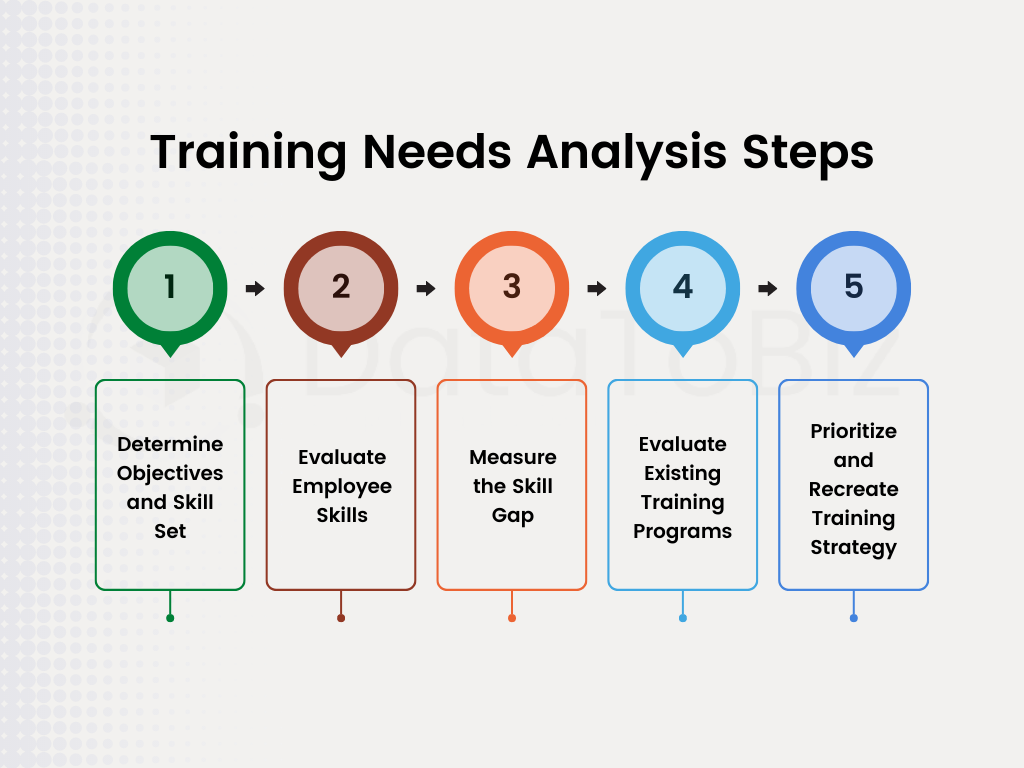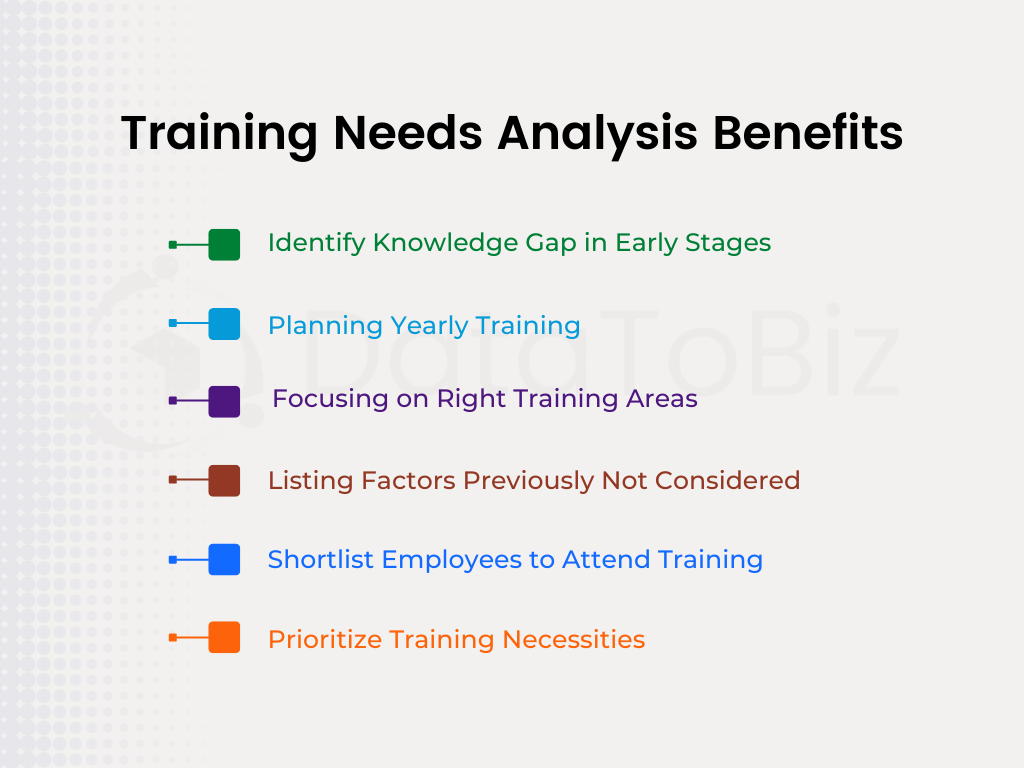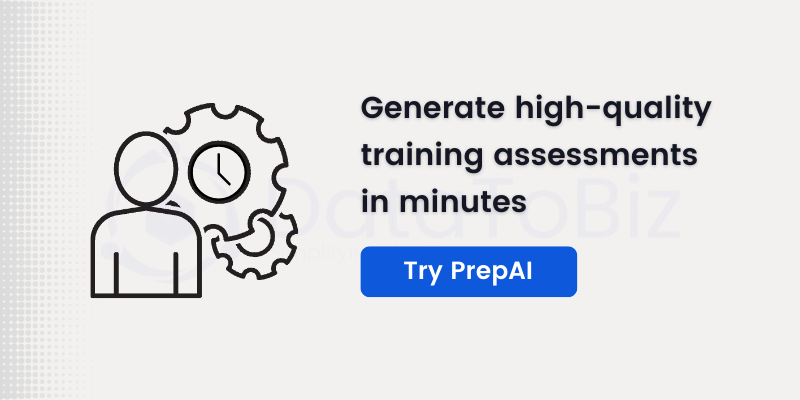Internal training is expensive, time-consuming, and effort-intensive. Training needs analysis can simplify the process and bring various benefits. We’ll discuss the role, process, types, and advantages of TNA for an enterprise.
Training employees for specific jobs is a common practice in most organizations. However, internal training processes are changing from traditional to modern methods. The use of technology, personalization of training programs for each employee, and providing long-term access to training material is now seen in various enterprises.
That said, all of this is possible when the enterprise knows exactly what training is required. For that, the top management is required to analyze training needs and list the objectives to determine how to structure and implement training. This is known as a Training Need Analysis or Training Need Assessment (TNA).
We’ll discuss the process in detail to understand what it involves and how TNA can benefit the enterprise.
What is Training Need Analysis?
According to LinkedIn Learning, close to 70% of employees prefer on-the-job training. Another report by the professional networking site says that 94% of employees think they will stay longer with an organization if they are involved in their learning and development. In fact, according to a report on Lorman, 70% of employees will quit a job for another if it offers training and development programs.
Training programs need to focus on employee skill development. You need a strong foundation to determine and create such training sessions. That’s where TNA comes into the picture.
Training Need Analysis is the process of determining the type of training your employees need in the given period so that they can show better performance and productivity at work. The primary goal of TNA is to identify the knowledge gaps across all verticals and empower employees to increase their work efficiency. You also need to consider employee satisfaction.
Let’s understand how TNA helps an enterprise.
Training Needs Analysis Methods
You need to first analyze the employees’ existing skills and knowledge. Then, you need to know the skills required for the job. Compare the two to determine the gaps and create a training program to bridge them. So how can you identify the knowledge gap? Here’s how.
Employee Assessments
There are various methods to conduct employee assessments. Skill tests, behavioral assessments, aptitude tests, gap analyses, etc., are some examples. You can use an AI question generator platform like PrepAI to automate the process of creating assessments.
360-Degree Feedback
This is a multi-level method where feedback is collected from employees through self-assessments, from peers, supervisors, managers, etc. The data is compared to create comprehensive training programs for employees.
Training Needs Analysis Questionnaire
A TNA questionnaire is short, simple, and highly effective. It is a self-assessment survey where employees are asked to rate themselves, and mark skills they feel are necessary for the job.
Performance Management Reports
The managers and HR teams create yearly or half-yearly performance management reports for each employee. The reports contain crucial information that can help create a better training program.
SWOT Analysis
SWOT stands for Strengths, Weaknesses, Opportunities, and Threats. This analysis can be conducted on the macro or micro level to get in-depth insights into the company and employee performance.
Training Needs Analysis Steps
The training needs analysis framework follows the below steps to determine the right direction for the training programs.

- Determine Objectives and Skill Set: The first step is to understand the business objectives and the skills necessary to achieve the goals.
- Evaluate Employee Skills: Next, you need to conduct assessments to evaluate employees to list their skills and knowledge.
- Measure the Skill Gap: Compare the required skills with available skills to identify the gap. You need to have detailed reports of the skill gap to plan an effective training program.
- Evaluate Existing Training Programs: Now, determine if the existing training programs are enough to bridge the gap or if you need to make changes and develop a new training process within the enterprise.
- Prioritize and Recreate Training Strategy: Align the requirements with business objectives and KPIs to prioritize which skills need to be taught first and how. Then, work on the training strategy to build a new model from scratch or make changes to the existing one.
Training Needs Analysis Models
TNA models are categorized into the following based on business requirements and targets.
New Employees
The training program for new employees will be different from the program planned for existing employees. Here, the focus is on onboarding and retention during the initial phase. You want new employees to understand your business processes, systems, and work culture. You want them to become a part of the existing teams and start working on the projects as per the teams’ requirements and specifications.
Existing Employees
The training model for existing employees aims at bettering their skills and knowledge. It also deals with non-technical/ interpersonal or soft skills. For example, selected employees can be trained to work on an exclusive project. They can be trained to increase personal efficiency and rectify their mistakes at work. Employees can also be trained in-house for their career growth.
Managers and Team Leaders
Employees in leadership roles require a wider skill set. Whether the team leads and managers were promoted within the enterprise or hired from another company, they must be trained in their specific positions. Decision-making, problem-solving, crisis management, communication, etc., are some important areas to focus on.
Types of Training Needs Analysis
Training need analysis can be of different types. You can use all or some in your enterprise, depending on your goals and budget.
Personal Analysis
This type of TNA deals with individual employees and their skills. You determine whether the employee requires training or not. And if yes, what kind of training do they require? Fortunately, you don’t need to work manually or spend weeks on personal analysis. The process is automated using special software developed for the purpose.
For example, you can use personal analysis to determine if the shortlisted employees are suitable for the managerial role and what level of training can make them efficient for the job. Also, you should know if/ how the employee can learn new responsibilities, software, policies, etc.
Work/Job Analysis
This type helps you understand the skills, knowledge, and expertise required to do the job. It emphasizes better performance and quality results. For example, when you hire a candidate as an accounts manager, you need to ensure they are trained to tackle all the roles and responsibilities of the position. Consider the skills the employee already has and create a training program that covers the gap.
Organizational Analysis
This is a macro approach to training and is handled by the top management. Start by determining whether or not your employees need training. What are your business goals and objectives? What are your short-term, mid-term, and long-term targets? Are your employees capable of achieving the targets with their existing skills and knowledge? Did you already train them for the jobs? What results did the previous training provide? How can you avoid making the same training mistakes?
Cost-Effectiveness Analysis
While training is necessary for business growth, you cannot ignore the cost of investment. You should get a return on the money you spend on training. Proper training methods increase ROI by delivering the expected results and taking you one step closer to your goals. You have to analyze if the existing training programs are cost-beneficial and make the necessary changes.
Performance Analysis
This type of TNA deals with employee performance on the job. Are the performance standards as desired? How can you improve the standards through training? What training practices will close the gap between the expected and actual performance?
Training Efficiency Analysis
Sometimes, training is not the solution to your problem. All efficiency issues cannot be solved by employee training. This type of TNA determines if you need to invest in training or if there are better alternatives to achieve your business goals. For example, building an in-house team is one way to deal with the knowledge gap. Outsourcing and hiring service providers is another way to increase efficiency, especially if you are on a tight schedule and don’t have the time to train your employees.
Training Needs Analysis Benefits
LMS (Learning Management System) is being used by organizations to provide training to employees as and when necessary. ShareKnowledge says that 83% of enterprises use LMS, while FinancesOnline says 72% of the companies feel they have a competitive advantage by using LMS and the latest technology for employee training.
You must know why training needs analysis is important. Let’s look at the benefits it offers to the business. However, the success of the training program depends on how well you use the data collected through TNA.

Identify Knowledge Gap in Early Stages
Training need analysis gives you a chance to solve issues in the early stages. You will know the severity of the knowledge gap in your enterprise if you conduct the analysis before making any vital decisions. This gives you more opportunities to rectify the situation and make changes to get the expected results. Follow the simplest procedure by creating a TNA questionnaire using PrepAI, an AI question generation platform, and get feedback from employees. Take a proactive stance instead of reacting and trying to minimize damage in the later stages.
Planning Yearly Training
If you have recurring training programs periodically, TNA provides the necessary data to plan the programs in advance, that too based on reliable data and insights. When you identify the skill and knowledge gap well before the training programs begin, you’ll have the time and resources to make changes and customize training to cover the gaps instead of focusing on the wrong or unnecessary aspects. It is cost-effective and increases ROI.
Focusing on Right Training Areas
You need to train employees for the right reasons. But how will you know if the reasons you consider important align with the actual situation? That’s where TNA is beneficial to your business. It helps you gather the necessary data to determine if your training programs target the right areas or not. Furthermore, you can postpone training or even stop it for the time being if there are no apparent knowledge gaps for the given job/ department.
Listing Factors Previously Not Considered
As your business grows, it can be challenging to create a training schedule for employees from different departments. You need more background information about employees, job specifications, etc., before implementing the training process. Training need analysis is useful at this point as you will have the data to not only see what is required but to also identify areas that you previously missed. In short, TNA fortifies your training programs at the micro-level to ensure your employees are trained in various areas and can become more productive at work.
Shortlist Employees to Attend Training
Not every employee needs training. Furthermore, some employees need more training than others. This data can be collected, analyzed, and processed through TNA. You will know exactly who requires another training session and which type of training will be the best for them. This allows you to optimize training costs by spending as much as necessary. You can also determine if the employee will improve with your in-house training or if you need to reconsider the options.
Prioritize Training Necessities
Another factor that emphasizes the training needs analysis is its role in prioritizing training programs. A business has many training programs based on employee experience, department requirements, additional skills, etc. With TNA, you can arrange the training programs in the order of priority and invest in the most crucial programs. The training sessions that haven’t been productive can be discontinued to create better programs.
Conclusion
Training Need Analysis is the way to streamline and revamp your training programs to achieve your goals. The sooner you implement TNA, the better control you’ll have over the entire process. The changes you make will have long-term benefits as long as you continue to monitor the training programs and employee performance.
It’s time to upgrade your technology and update your systems to provide premium quality training for your employees. Take time to determine the training tools you require to strengthen your in-house teams. After all, productive and happy employees can bring success to the business.






